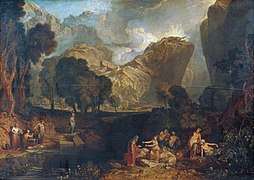Apple of Discord
An apple of discord is the core, kernel, or crux of an argument, or a small matter that could lead to a bigger dispute.[1]


It is a reference to the Golden Apple of Discord (Greek: μῆλον τῆς Ἔριδος) in the story The Judgement of Paris which, according to Greek mythology, was what the goddess Eris (Gr. Ἔρις, "Strife") tossed in the midst of the feast of the gods at the wedding of Peleus and Thetis as a prize of beauty, thus sparking a vanity-fueled dispute among Hera, Athena, and Aphrodite that eventually led to the Trojan War[2]
Derivative uses
Because of this, the Roman goddess corresponding to the Greek Eris was named "Discordia". Also, in German and in Dutch, the words are used a lot more often colloquially than in English, though in German the colloquial form is not Apfel der Zwietracht (lit. "Apple of Discord") but Zankapfel ("Quarrel-apple") and rarely Erisapfel; the Dutch is twistappel ("Strife-apple").
In the Eixample district of Barcelona, there is a block nicknamed in Spanish La manzana de la discordia (Catalan: L'illa de la discòrdia). The reason for this usage is that manzana means both "apple" and "city block" in Spanish. It was so named ("block of discord") because it features four different interpretations of Modernisme architecture: Antoni Gaudí's Casa Batlló, Lluís Domènech i Montaner's Casa Lleó Morera, Josep Puig i Cadafalch's Casa Amatller, and Enric Sagnier's Casa Mulleras.
"To the Most Beautiful"
In some later sources, Eris inscribed on the apple "for the fair"[3] or "to the most beautiful" before tossing it. The most popular version of the inscription is ΤΗ ΚΑΛΛΙΣΤΗΙ (Ancient Greek: τῇ καλλίστῃ, romanized: tē(i) kallistē(i), Modern Greek: τη καλλίστη ti kallisti; "for/to the most beautiful").[4] Καλλίστῃ is the dative singular of the feminine superlative of καλός, beautiful. In Latin sources, the word is formosissima.[5]
References
| Look up apple of discord in Wiktionary, the free dictionary. |
- Timothy L. Gall; Susan B. Gall (1 January 2006). The Lincoln library of Greek & Roman mythology. Lincoln Library Press. pp. 16–. ISBN 978-0-912168-21-0.
- Apollodorus. "E.3.2". The Library Epitome. Theoi Project. Translated by J. G. Frazer. Retrieved 7 December 2017.
- Lucian. "The Judgement of Paris". Dialogues of the Gods. Theoi Project. Translated by H. W. & F. G. Fowler. Retrieved 7 December 2017.
- Randall L. Schweller (3 April 2014). Maxwell's Demon and the Golden Apple: Global Discord in the New Millennium. JHU Press. pp. 10–. ISBN 978-1-4214-1278-8.
- Hyginus. "92". Fabulae. Theoi Project. Translated by Mary Grant. Retrieved 7 December 2017.